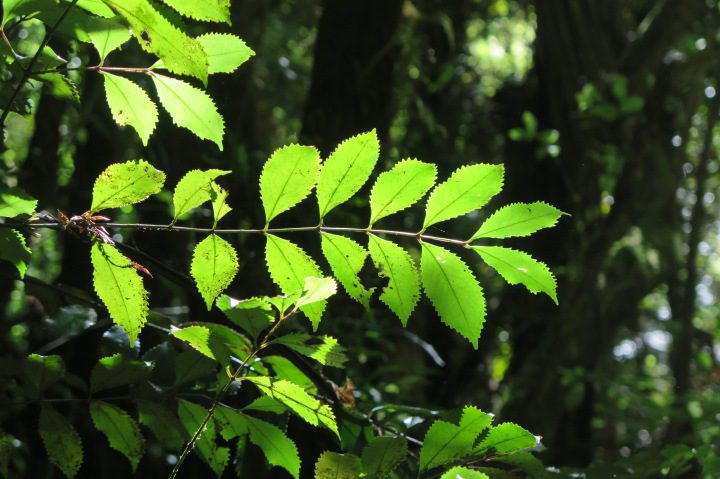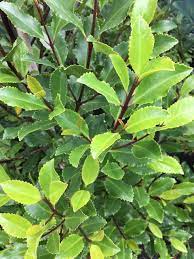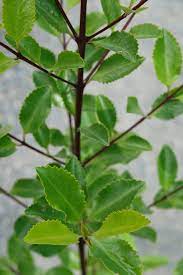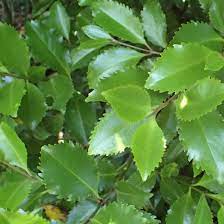Laurelia novae-zelandiae, commonly known as Pukatea, is a species of tree endemic to New Zealand. Belonging to the monotypic genus Laurelia in the family Atherospermataceae, Pukatea is renowned for its towering stature, lush foliage, and cultural significance to the indigenous Māori people.
Pukatea trees typically grow in wetland areas, including swamp forests and riverbanks, where they thrive in the moist, fertile soils of New Zealand’s temperate climate. These trees can reach impressive heights, with mature specimens often exceeding 30 meters (approximately 100 feet) in height, making them one of the tallest trees in New Zealand forests.
The leaves of Pukatea are glossy and dark green, with a distinctive lanceolate shape and serrated margins. The tree produces small, inconspicuous flowers that give way to spherical fruits containing numerous seeds. The bark of mature trees is rough and furrowed, providing habitat for various epiphytic plants and mosses.
In addition to its ecological importance as a habitat and food source for native wildlife, Pukatea holds cultural significance to the Māori people. The bark of the tree was traditionally used by Māori healers for its medicinal properties. It was brewed into a tea or infusion and ingested as a treatment for various ailments, including stomachaches, fevers, and infections.
Furthermore, Pukatea is revered in Māori mythology and folklore, where it is often associated with spiritual and ancestral connections. The tree is considered tapu (sacred) by some Māori tribes, and its wood was used in the construction of waka (canoes) and other ceremonial objects.
Today, Pukatea continues to be valued for its ecological and cultural significance. Conservation efforts aim to protect and restore wetland habitats where Pukatea grows, ensuring the survival of this iconic species and the biodiversity it supports.
Additionally, the cultural importance of Pukatea remains strong among the Māori people, who continue to honor and respect the tree as an integral part of their heritage.
The Botanical Description of Laurelia novae-zelandiae
1. Evergreen Tree: Laurelia novae-zelandiae, commonly known as pukatea, is an evergreen tree belonging to the family Atherospermataceae. It typically grows to heights of 20 to 30 meters, with a straight trunk and dense foliage.
2. Leaves: The leaves of Laurelia novae-zelandiae are glossy green, elliptical to lanceolate in shape, and arranged alternately along the branches. They have a leathery texture and serrated margins.
3. Flowers: Pukatea trees produce small, inconspicuous flowers that are creamy-white in color and borne in clusters. The flowers are fragrant and attract pollinators such as bees and butterflies.
4. Fruits: The fruits of Laurelia novae-zelandiae are small, spherical drupes that ripen to a dark purple-black color. Each fruit contains a single seed and is dispersed by birds attracted to its sweet flesh.
5. Bark: The bark of pukatea trees is smooth and grayish-brown when young, becoming rough and fissured with age. It exudes a resinous sap when damaged and has been used traditionally for medicinal purposes.
6. Habitat: Laurelia novae-zelandiae is native to New Zealand and can be found in lowland and montane forests, often near waterways or in damp, shady areas. It prefers fertile, well-drained soils.
7. Growth Rate: Pukatea trees have a moderate growth rate, with young trees often growing quickly in favorable conditions. However, they can live for several hundred years, with some specimens reaching ages of 500 years or more.
8. Root System: The root system of Laurelia novae-zelandiae is shallow and spreading, providing stability in the often wet and unstable soils of its habitat. It can also form root suckers, allowing for vegetative propagation.
9. Canopy: The canopy of pukatea trees is dense and bushy, providing shelter and habitat for a variety of bird species, insects, and epiphytic plants.
10. Regeneration: Laurelia novae-zelandiae can regenerate from both seeds and vegetative means, making it resilient to disturbances such as logging or natural events like storms.
11. Ecological Importance: Pukatea trees play a crucial role in the ecology of New Zealand forests, contributing to biodiversity, soil stabilization, and water retention.
12. Conservation Status: While not currently considered threatened, Laurelia novae-zelandiae populations may be at risk due to habitat loss, invasive species, and climate change, highlighting the need for conservation efforts.
The Geographic Distribution of Laurelia novae-zelandiae

1. New Zealand: Laurelia novae-zelandiae is endemic to New Zealand and is found throughout both the North and South Islands, primarily in lowland and montane forests.
2. North Island: Pukatea trees are distributed widely across the North Island of New Zealand, from the northernmost tip to the southern regions, particularly in damp, forested areas.
3. South Island: While less common than in the North Island, Laurelia novae-zelandiae can also be found in various regions of the South Island, including Nelson, Marlborough, West Coast, Canterbury, and Otago.
4. Coastal Areas: Pukatea trees are often found in coastal areas, where they thrive in the moist, temperate climates and provide valuable habitat for native wildlife.
5. Riparian Zones: Laurelia novae-zelandiae is frequently found along rivers, streams, and wetland margins, where its roots help stabilize banks and prevent erosion.
6. Montane Forests: In montane forests, pukatea trees can be found at higher elevations, often forming part of mixed-species forests with other native tree species.
7. Conservation Areas: Many protected areas in New Zealand, such as national parks and reserves, harbor significant populations of Laurelia novae-zelandiae, contributing to their conservation.
8. Cultivation: While primarily a wild species, pukatea trees may also be cultivated in botanical gardens or arboreta for educational and conservation purposes.
9. Restoration Projects: Efforts to restore native forests in New Zealand often include planting Laurelia novae-zelandiae trees, recognizing their ecological importance and cultural significance.
10. Threats: Despite its widespread distribution, Laurelia novae-zelandiae populations face threats from habitat destruction, invasive species, climate change, and disease, highlighting the need for conservation action.
11. Indigenous Knowledge: Indigenous Māori people have a deep cultural connection to Laurelia novae-zelandiae, using it for medicinal purposes, timber, and in traditional ceremonies and rituals.
The Chemical Composition of Laurelia novae-zelandiae
1. Alkaloids: Laurelia novae-zelandiae contains various alkaloid compounds, including pukateine and laurifoline, which have been studied for their pharmacological properties.
2. Tannins: Tannin compounds are present in the bark and leaves of pukatea trees, contributing to their astringent and medicinal qualities.
3. Flavonoids: Flavonoid compounds, such as quercetin and kaempferol, are found in the leaves and flowers of Laurelia novae-zelandiae, with potential antioxidant and anti-inflammatory effects.
4. Essential Oils: The leaves and bark of pukatea trees contain volatile essential oils, which may have antimicrobial and insecticidal properties.
5. Resins: Pukatea trees produce resinous substances, which have been used traditionally for their healing and protective properties.
6. Lignans: Some lignan compounds have been identified in Laurelia novae-zelandiae, with potential health benefits such as antioxidant and estrogenic effects.
7. Phenolic Compounds: Phenolic compounds, including phenolic acids and flavonols, are present in various parts of the pukatea tree and contribute to its medicinal properties.
8. Glycosides: Glycoside compounds are found in the leaves and bark of Laurelia novae-zelandiae, with potential cardiovascular and anti-inflammatory effects.
9. Sterols: Sterol compounds, such as β-sitosterol, are present in the seeds and oil of pukatea trees, with potential cholesterol-lowering and anti-inflammatory effects.
10. Terpenoids: Some terpenoid compounds have been identified in Laurelia novae-zelandiae, contributing to its aromatic properties and potential therapeutic effects.
11. Carbohydrates: Carbohydrate compounds, including polysaccharides and sugars, are present in various parts of the pukatea tree and serve as energy sources and structural components.
12. Proteins: Protein compounds are found in the seeds and leaves of Laurelia novae-zelandiae, providing essential nutrients and amino acids.
13. Minerals: Pukatea trees absorb minerals from the soil, including calcium, magnesium, potassium, and trace elements, which are important for overall plant health and function.
14. Vitamins: While not a significant source of vitamins, Laurelia novae-zelandiae may contain small amounts of vitamin C, vitamin E, and other antioxidant vitamins in its leaves and fruits.
Read Also: Scrapie in Sheep and Goats: Description, Damages Caused, Control and Preventive Measures
The Medicinal Health Benefits Of Laurelia novae-zelandiae (Pukatea)

1. Anti-inflammatory: Pukatea exhibits anti-inflammatory properties, which can help reduce inflammation and alleviate symptoms associated with conditions such as arthritis, rheumatism, and inflammatory bowel disease.
2. Analgesic: The analgesic effects of Laurelia novae-zelandiae make it useful for relieving pain, including headaches, muscle aches, and menstrual cramps.
3. Antimicrobial: Pukatea contains compounds with antimicrobial properties, which can help fight against bacterial, viral, and fungal infections, promoting overall health and immune function.
4. Antioxidant: As a rich source of antioxidants, pukatea helps neutralize free radicals in the body, reducing oxidative stress and lowering the risk of chronic diseases such as heart disease, cancer, and diabetes.
5. Digestive Aid: Pukatea has been traditionally used to support digestive health, relieving symptoms of indigestion, bloating, and gastrointestinal discomfort.
6. Respiratory Support: The expectorant and bronchodilator properties of Laurelia novae-zelandiae make it beneficial for respiratory conditions such as coughs, colds, and asthma.
7. Cardiovascular Health: Some studies suggest that pukatea may help support cardiovascular health by lowering cholesterol levels, improving blood circulation, and reducing the risk of heart disease.
8. Wound Healing: Topical application of pukatea extracts or ointments can promote wound healing, reduce inflammation, and prevent infection, accelerating the recovery process.
9. Relaxation: Pukatea has mild sedative properties, promoting relaxation, reducing stress, and improving sleep quality when used in aromatherapy or herbal preparations.
10. Immune Boosting: Regular consumption of pukatea may strengthen the immune system, making the body more resistant to infections and diseases.
11. Liver Support: Pukatea has been traditionally used to support liver health and detoxification processes, improving overall liver function and promoting detoxification.
12. Antispasmodic: The antispasmodic properties of Laurelia novae-zelandiae can help relieve muscle spasms, cramps, and tension, promoting relaxation and pain relief.
13. Antiallergic: Some research suggests that pukatea may have antiallergic effects, reducing allergic reactions and symptoms such as itching, sneezing, and congestion.
14. Antiulcer: Pukatea extracts have been studied for their potential antiulcer effects, which may help protect the gastric mucosa and prevent the formation of ulcers.
15. Anti-anxiety: Pukatea’s calming and anxiolytic effects make it useful for reducing anxiety, nervousness, and tension, promoting mental and emotional well-being.
16. Anticancer: Preliminary research indicates that pukatea may have anticancer properties, inhibiting the growth and proliferation of cancer cells and reducing the risk of tumor development.
The Methods of Usage to Achieve the Provided Health Benefits Of Laurelia novae-zelandiae (Pukatea)
1. Herbal Tea: Prepare a soothing herbal tea by steeping dried pukatea leaves in hot water for 5-10 minutes. Drink 1-2 cups daily to enjoy its medicinal benefits.
2. Tincture: Take pukatea tincture orally by diluting it in water or juice according to the manufacturer’s instructions. This concentrated form allows for easy dosing and absorption of its medicinal compounds.
3. Topical Application: Apply pukatea extracts or ointments topically to wounds, cuts, or skin irritations to promote healing, reduce inflammation, and prevent infection.
4. Inhalation: Inhale the steam from a bowl of hot water infused with pukatea leaves or essential oil to support respiratory health, relieve congestion, and promote relaxation.
5. Aromatherapy: Diffuse pukatea essential oil in a room using a diffuser or add a few drops to a warm bath to create a calming atmosphere and promote stress relief.
6. Poultice: Create a poultice by crushing fresh pukatea leaves and applying them directly to sore muscles, joints, or insect bites to reduce pain and inflammation.
7. Capsules: Take pukatea capsules or tablets orally as a convenient way to incorporate its medicinal benefits into your daily routine. Follow the recommended dosage on the product label.
8. Culinary Use: Incorporate dried pukatea leaves into cooking and baking recipes to add flavor and potential health benefits to dishes such as soups, stews, and herbal infusions.
9. Massage Oil: Mix pukatea essential oil with a carrier oil such as coconut or jojoba oil and use it for massage to relieve muscle tension, promote relaxation, and improve circulation.
10. Mouthwash or Gargle: Rinse the mouth or gargle with a diluted solution of pukatea tea to promote oral hygiene, soothe sore throat symptoms, and reduce inflammation in the mouth and throat.
11. Compress: Soak a clean cloth in warm pukatea tea and apply it as a warm compress to painful or inflamed areas of the body to promote relaxation and pain relief.
12. Herbal Bath: Add dried pukatea leaves or essential oil to bathwater to create a therapeutic herbal bath, promoting relaxation, soothing sore muscles, and relieving stress.
13. Culinary Infusion: Infuse pukatea leaves in hot water or oil to create flavorful infusions that can be used in cooking, baking, or as a base for herbal beverages.
The Side Effects Of Using Laurelia novae-zelandiae Medicinal Plant
1. Allergic Reactions: Some individuals may experience allergic reactions to Laurelia novae-zelandiae, especially those sensitive to plants in the Atherospermataceae family. Symptoms may include skin rash, itching, swelling, or respiratory distress.
2. Gastrointestinal Upset: High doses of pukatea preparations may cause gastrointestinal upset, including nausea, vomiting, diarrhea, or stomach cramps. It’s advisable to start with low doses and gradually increase as tolerated.
3. Drug Interactions: Pukatea may interact with certain medications, particularly those metabolized by the liver or affecting blood clotting. Consult with a healthcare professional before using pukatea if you are taking medications.
4. Pregnancy and Breastfeeding: While there is limited information on the safety of pukatea during pregnancy and breastfeeding, pregnant and breastfeeding women should avoid its use unless under the guidance of a healthcare provider.
5. Photosensitivity: Some individuals may experience increased sensitivity to sunlight or UV radiation when using pukatea topically, especially in high concentrations or prolonged exposure.
6. Potential Toxicity: Ingesting large quantities of pukatea seeds or extracts may result in toxicity symptoms, including nausea, vomiting, dizziness, or liver damage. Keep pukatea products out of reach of children and pets.
7. Skin Irritation: Topical application of pukatea extracts or oils may cause skin irritation or allergic reactions in sensitive individuals. Perform a patch test before using pukatea products on large areas of the skin.
8. Respiratory Irritation: Inhaling concentrated pukatea essential oil or steam may irritate the respiratory tract in sensitive individuals, causing coughing, wheezing, or shortness of breath.
9. Interaction with Herbal Supplements: Pukatea may interact with other herbal supplements or natural remedies, potentially enhancing or inhibiting their effects. Consult with a healthcare professional before combining pukatea with other supplements.
10. Liver Toxicity: Some individuals may be at risk of liver toxicity when using pukatea products, particularly in high doses or over prolonged periods. Monitor liver function and discontinue use if symptoms of liver damage occur.
11. Central Nervous System Effects: Pukatea’s sedative properties may cause drowsiness, dizziness, or impaired coordination in some individuals, especially when combined with other sedative medications or alcohol.
12. Cardiovascular Effects: High doses of pukatea may affect blood pressure or heart rate in susceptible individuals, particularly those with pre-existing cardiovascular conditions. Monitor cardiovascular parameters if using pukatea for medicinal purposes.
13. Hormonal Effects: Some compounds found in pukatea may have hormonal effects, potentially affecting hormone levels or reproductive function in certain individuals. Exercise caution when using pukatea, especially in hormone-sensitive conditions.
14. Interaction with Medical Conditions: Individuals with underlying medical conditions such as liver disease, kidney disease, diabetes, or bleeding disorders should use pukatea with caution and under the supervision of a healthcare professional.
Read Also: 17 Medicinal Health Benefits Of Lotus Seed (Nelumbo nucifera)
The Scientific Research and Studies of Laurelia novae-zelandiae (Pukatea)

1. Antioxidant Activity: Research has demonstrated the antioxidant activity of Laurelia novae-zelandiae extracts, which may help protect against oxidative stress-related diseases such as cardiovascular disease and cancer.
2. Anti-inflammatory Effects: Studies suggest that pukatea exhibits anti-inflammatory properties, inhibiting inflammatory pathways and reducing inflammation associated with conditions such as arthritis and inflammatory bowel disease.
3. Antimicrobial Properties: Laurelia novae-zelandiae extracts have shown antimicrobial activity against various bacteria, fungi, and viruses, suggesting potential therapeutic applications for treating infections.
4. Wound Healing: Preliminary research indicates that pukatea extracts may promote wound healing by accelerating the formation of granulation tissue, increasing collagen deposition, and enhancing epithelialization.
5. Respiratory Support: Some studies have explored the respiratory-supporting effects of Laurelia novae-zelandiae, including its potential as a bronchodilator, expectorant, and cough suppressant for respiratory conditions such as asthma and bronchitis.
6. Gastrointestinal Health: Research suggests that pukatea may have gastroprotective effects, reducing gastric ulcer formation and enhancing gastric mucosal defense mechanisms, possibly through its antioxidant and anti-inflammatory properties.
The Safety Precautions and Recommendations In Using Laurelia novae-zelandiae (Pukatea) Medicinal Plant
1. Consultation with Healthcare Professional: Before using Laurelia novae-zelandiae for medicinal purposes, consult with a qualified healthcare professional, especially if you have underlying medical conditions, are pregnant or breastfeeding, or are taking medications.
2. Dosage Considerations: Follow recommended dosage guidelines for pukatea products, and start with low doses to assess tolerance and minimize the risk of adverse effects. Avoid exceeding recommended doses unless under medical supervision.
3. Quality and Purity: Choose reputable sources for pukatea products to ensure quality, purity, and potency. Look for products that have been tested for contaminants and standardized for active ingredients.
4. Allergy Testing: Perform a patch test before using pukatea products topically to check for skin sensitivities or allergic reactions. Discontinue use if any adverse reactions occur and seek medical advice if necessary.
5. Monitoring for Adverse Effects: Monitor for any adverse effects or changes in health status when using pukatea, especially if using it for an extended period. Discontinue use and seek medical attention if any concerning symptoms arise.
6. Interaction with Medications: Be cautious when combining pukatea with medications, as it may interact with certain drugs, including blood thinners, anticoagulants, and medications metabolized by the liver. Consult with a healthcare professional before use.
7. Pregnancy and Breastfeeding: Pregnant and breastfeeding women should avoid using pukatea unless under the guidance of a healthcare provider, as safety data is limited.
8. Keep Out of Reach of Children: Store pukatea products out of reach of children and pets to prevent accidental ingestion or misuse.
9. Adherence to Label Instructions: Follow the instructions provided on pukatea product labels regarding dosage, administration, and storage to ensure safety and efficacy.
10. Reporting Adverse Events: Report any adverse events or side effects associated with pukatea use to appropriate regulatory authorities or healthcare professionals to contribute to ongoing safety monitoring and evaluation.
11. Avoiding Prolonged Use: Limit the duration of pukatea use to short-term or intermittent periods, especially if using it for medicinal purposes, to reduce the risk of potential side effects or toxicity.
12. Individual Sensitivities: Be mindful of individual sensitivities and reactions to pukatea, as some individuals may be more susceptible to adverse effects due to factors such as allergies, medical conditions, or genetic predispositions.
13. Herbal Interactions: Exercise caution when combining pukatea with other herbal supplements or natural remedies, as interactions may occur, potentially enhancing or inhibiting their effects. Consult with a healthcare professional before combining herbs.
14. Discontinue Use if Necessary: If any adverse effects or concerns arise while using pukatea, discontinue use immediately and seek medical advice if necessary. It’s essential to prioritize safety and well-being when using herbal remedies.
FAQs About Laurelia novae-zelandiae (Pukatea) Medicinal Plant
1. Is Laurelia novae-zelandiae safe for everyone to use?
While Laurelia novae-zelandiae is generally considered safe for most people when used appropriately, certain individuals may be more sensitive to its effects or at higher risk of adverse reactions. It’s essential to consult with a healthcare professional before using pukatea, especially if you have underlying medical conditions, are pregnant or breastfeeding, or are taking medications.
2. How can I identify Laurelia novae-zelandiae in the wild?
Laurelia novae-zelandiae, commonly known as pukatea, is a native tree species found in New Zealand and other regions. It can be identified by its distinctive glossy green leaves, small white flowers, and spherical fruits. It typically grows in damp forests or swampy areas and is part of the Atherospermataceae family.
3. What are the traditional uses of Laurelia novae-zelandiae?
Traditional uses of Laurelia novae-zelandiae, or pukatea, include its medicinal properties for treating various ailments such as inflammation, pain, respiratory conditions, and gastrointestinal issues. It has also been used for its timber, which is valued for its durability and resistance to decay.
4. Can Laurelia novae-zelandiae be used for culinary purposes?
While Laurelia novae-zelandiae is not commonly used for culinary purposes, some indigenous communities in New Zealand have traditionally consumed parts of the tree, including the fruits, seeds, and young shoots. However, it’s essential to ensure proper preparation and knowledge of any potential toxins or allergens present in the plant.
5. Are there any potential risks or side effects associated with using Laurelia novae-zelandiae?
Like any herbal remedy, Laurelia novae-zelandiae may cause adverse effects or interactions in some individuals, particularly if used in high doses or for prolonged periods. These may include allergic reactions, gastrointestinal upset, drug interactions, or skin irritation. It’s essential to use pukatea cautiously and discontinue use if any adverse effects occur.
6. Is there scientific evidence supporting the medicinal benefits of Laurelia novae-zelandiae?
While traditional uses of Laurelia novae-zelandiae have been documented for centuries, scientific research on its medicinal properties is still relatively limited. However, preliminary studies suggest that pukatea may have anti-inflammatory, antioxidant, antimicrobial, and wound-healing effects, among others. Further research is needed to fully understand its therapeutic potential and mechanisms of action.
7. Can Laurelia novae-zelandiae interact with medications or other herbal supplements?
Yes, Laurelia novae-zelandiae may interact with certain medications or other herbal supplements, particularly those metabolized by the liver or affecting blood clotting. It’s essential to consult with a healthcare professional before using pukatea, especially if you are taking medications or other herbal remedies, to avoid potential interactions or adverse effects.
8. How should Laurelia novae-zelandiae be stored and handled to maintain its potency and safety?
Store Laurelia novae-zelandiae products in a cool, dry place away from direct sunlight and moisture to preserve their potency and quality. Follow any specific storage instructions provided on product labels to ensure maximum effectiveness and safety. Additionally, keep pukatea products out of reach of children and pets to prevent accidental ingestion or misuse.

